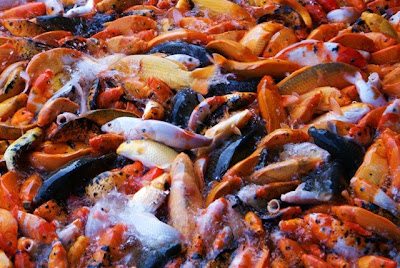




The view of Nanning from that 9-storey tower I posted above. Note the dense urban lanscape and things (like the bridge) constantly "under construction", all nestled within lush vegetation and encroaching on the farmland. I think it's symbolic of China...



Indeed it is...
April 17, 2009 - Day 5 - Longji rice fields
The climax of the trip, and rightly so. While they're not the only place that terraced rice fields can be found, these are particularly large. These are actually a part of a larger rice field area known as the Longsheng Terraces, although what separates the two main fields is simply distance. Otherwise, they're pretty similar.

Being a mountain top terrace field, it does include a walk up the mountain. Free of charge. Actually, I'm lying- it wasn't free. You have you buy a ticket before they let you go up...
 After hiking to the highest lookout point, you're greeted by an amazing view of the terraces cradling the village the farmers live in. As you can see, they've only just started to fill the fields with water and over the next few months, the entire mountain side will start to look like a giant stepped mirror with all the strips of water reflecting the sky. Click here for a full-sized version of this picture.
After hiking to the highest lookout point, you're greeted by an amazing view of the terraces cradling the village the farmers live in. As you can see, they've only just started to fill the fields with water and over the next few months, the entire mountain side will start to look like a giant stepped mirror with all the strips of water reflecting the sky. Click here for a full-sized version of this picture. While many in the village still farm, others are very happy to sell you lots of things to supplement their income. Things like handmade scarves...
While many in the village still farm, others are very happy to sell you lots of things to supplement their income. Things like handmade scarves...  Much like the rest of China, the villagers have embraced tourism as a means of earning extra income. But the village is still a functional farming village first, evidenced by people going about their daily lives. Click here for a full-sized version.
Much like the rest of China, the villagers have embraced tourism as a means of earning extra income. But the village is still a functional farming village first, evidenced by people going about their daily lives. Click here for a full-sized version. As mentioned before, embracing tourism means almost every building in the village has been converted into a restaurant or a hotel. We stayed at the Longji One Hotel, which is a relatively new 4 storey building. Aside from the amazing view, the photojournalist owner and his wife have given the hotel fantastic charm. The hotel is entirely wood and all the furnishings are wood, wicker, or rope. Note the slices of tree trunk that act as stools and table legs.
As mentioned before, embracing tourism means almost every building in the village has been converted into a restaurant or a hotel. We stayed at the Longji One Hotel, which is a relatively new 4 storey building. Aside from the amazing view, the photojournalist owner and his wife have given the hotel fantastic charm. The hotel is entirely wood and all the furnishings are wood, wicker, or rope. Note the slices of tree trunk that act as stools and table legs. Or these coat hangers. The hotel is actually extremely comfortable with all the modern amenities. And with the brown tones complementing the greenery outside, the quiet mountain range punctuated by roosters crowing and pigs oinking in the distance, the fresh air carrying the faint smell of... well... manure mostly... it's one of the most calming experiences imaginable.
Or these coat hangers. The hotel is actually extremely comfortable with all the modern amenities. And with the brown tones complementing the greenery outside, the quiet mountain range punctuated by roosters crowing and pigs oinking in the distance, the fresh air carrying the faint smell of... well... manure mostly... it's one of the most calming experiences imaginable. It's a rock. That looks like an elephant...
It's a rock. That looks like an elephant...
Actually, the whole park is elephant themed...
"AND"?!? No wonder the seats are always empty...
And that's it. Like that, the tour was over, I was back in the crowded metropolis of Hong Kong, wondering how all the terraces were replaced with high rises so quickly. A day after that, I was back in Japan.
And for all that I thought was similar between Japan and China, I can see now just how wrong I was...
I'll have more time to explore that side of things as well, as starting from next week, I'll be off to various other parts of Japan. See you then...


No comments:
Post a Comment